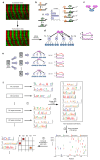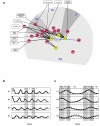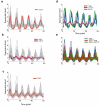BRNI: Modular analysis of transcriptional regulatory programs
- PMID: 19457258
- PMCID: PMC2694189
- DOI: 10.1186/1471-2105-10-155
BRNI: Modular analysis of transcriptional regulatory programs
Abstract
Background: Transcriptional responses often consist of regulatory modules - sets of genes with a shared expression pattern that are controlled by the same regulatory mechanisms. Previous methods allow dissecting regulatory modules from genomics data, such as expression profiles, protein-DNA binding, and promoter sequences. In cases where physical protein-DNA data are lacking, such methods are essential for the analysis of the underlying regulatory program.
Results: Here, we present a novel approach for the analysis of modular regulatory programs. Our method - Biochemical Regulatory Network Inference (BRNI) - is based on an algorithm that learns from expression data a biochemically-motivated regulatory program. It describes the expression profiles of gene modules consisting of hundreds of genes using a small number of regulators and affinity parameters. We developed an ensemble learning algorithm that ensures the robustness of the learned model. We then use the topology of the learned regulatory program to guide the discovery of a library of cis-regulatory motifs, and determined the motif compositions associated with each module.We test our method on the cell cycle regulatory program of the fission yeast. We discovered 16 coherent modules, covering diverse processes from cell division to metabolism and associated them with 18 learned regulatory elements, including both known cell-cycle regulatory elements (MCB, Ace2, PCB, ACCCT box) and novel ones, some of which are associated with G2 modules. We integrate the regulatory relations from the expression- and motif-based models into a single network, highlighting specific topologies that result in distinct dynamics of gene expression in the fission yeast cell cycle.
Conclusion: Our approach provides a biologically-driven, principled way for deconstructing a set of genes into meaningful transcriptional modules and identifying their associated cis-regulatory programs. Our analysis sheds light on the architecture and function of the regulatory network controlling the fission yeast cell cycle, and a similar approach can be applied to the regulatory underpinnings of other modular transcriptional responses.
Figures






References
-
- Akutsu T, Miyano S, Kuhara S. Identification of genetic networks from a small number of gene expression patterns under the Boolean network model. Pacific Symposium on Biocomputing. 1999:17–28. - PubMed
-
- Kim S, Imoto S, Miyano S. Dynamic Bayesian network and nonparametric regression for nonlinear modeling of gene networks from time series gene expression data. Bio Systems. 2004;75:57–65. - PubMed
-
- Liao JC, Boscolo R, Yang YL, Tran LM, Sabatti C, Roychowdhury VP. Network component analysis: reconstruction of regulatory signals in biological systems. Proceedings of the National Academy of Sciences of the United States of America. 2003;100:15522–15527. doi: 10.1073/pnas.2136632100. - DOI - PMC - PubMed
Publication types
MeSH terms
Grants and funding
LinkOut - more resources
Full Text Sources
Molecular Biology Databases

